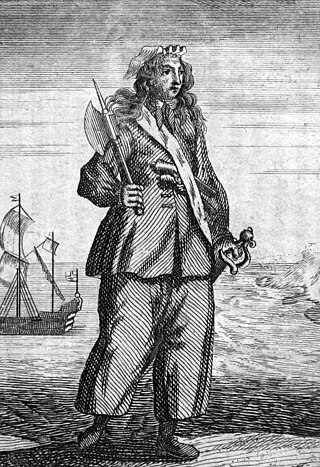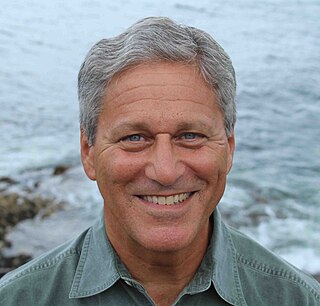
Jolly Roger is the traditional English name for the ensign flown to identify a pirate ship preceding or during an attack, during the early 18th century. The vast majority of such flags flew the motif of a human skull, or “Death's Head”, often accompanied by other elements, on a black field, sometimes called the "Death's Head flag" or just the "black flag".

Bartholomew Roberts, born John Roberts, was a Welsh pirate who was, measured by vessels captured, the most successful pirate of the Golden Age of Piracy. During his piratical career, he took over 400 prize ships, although most were mere fishing boats. Roberts raided ships off the Americas and the West African coast between 1719 and 1722; he is also noted for creating his own pirate code, and adopting an early variant of the Skull and Crossbones flag.
Captain Samuel Bellamy, later known as "Black Sam" Bellamy, was an English sailor turned pirate during the early 18th century. He is best known as the wealthiest pirate in recorded history, and one of the faces of the Golden Age of Piracy. Though his known career as a pirate captain lasted little more than a year, he and his crew captured at least 53 ships.

Mary Read, was an English pirate. She and Anne Bonny were among the few female pirates during the "Golden Age of Piracy".
Benjamin Hornigold was an English pirate towards the end of the Golden Age of Piracy.

Anne Bonny was a pirate who served under John "Calico Jack" Rackham. Amongst the few recorded female pirates in history, she has become one of the most recognized pirates of the Golden Age of Piracy as well as in the history of piracy in general.

Edward Low was a pirate of English origin during the latter days of the Golden Age of Piracy, in the early 18th century. Low was born into poverty in Westminster, London, and was a thief from an early age. He moved to Boston, Massachusetts, as a young man. His wife died in childbirth in late 1719. Two years later, he became a pirate, operating off the coasts of New England and the Azores, and in the Caribbean.

Olivier Levasseur, was a French pirate, nicknamed La Buse or La Bouche in his early days for the speed and ruthlessness with which he always attacked his enemies as well as his ability to verbally attack his opponents. He is known for allegedly hiding one of the biggest treasures in pirate history, estimated at $1 billion, and leaving a cryptogram behind with clues to its whereabouts.

The Namibia Premier League (NPL) was the highest level of domestic association football in Namibia until it was disbanded following the 2018-19 season. The league was established in 1990 and was trimmed to 12 teams from the traditional 16 in 2005. It was disbanded in 2020 after ongoing problems with the Namibia Football Association, which finally ended their relationship. The NFA founded the Namibia Football Premier League to replace it. The new league kicked off with the 2022-2023 season with African Stars against UNAM FC at the Hage Geingob Rugby Stadium.
The Namibia FA Cup, officially Bidvest Namibia Cup, is an association football tournament for Namibian clubs.

A General History of the Robberies and Murders of the most notorious Pyrates, or simply A General History of the Pyrates, is a 1724 book published in Britain containing biographies of contemporary pirates, which was influential in shaping popular conceptions of pirates. The prime source for the biographies of many well-known pirates, the book gives an almost mythical status to the more colourful characters, and it is likely that the author used considerable artistic license in his accounts of pirate conversations. It is not considered a reliable historical source by many modern scholars and academics of pirate history and the root of most pirate misconceptions throughout modern history.

In English-speaking popular culture, the modern pirate stereotype owes its attributes mostly to the imagined tradition of the 18th-century Caribbean pirate sailing off the Spanish Main and to such celebrated 20th-century depictions as Captain Hook and his crew in the theatrical and film versions of J. M. Barrie's Peter Pan, Robert Newton's portrayal of Long John Silver in the 1950 film adaptation of the Robert Louis Stevenson novel Treasure Island, and various adaptations of the Middle Eastern pirate, Sinbad the Sailor. In these and countless other books, films, and legends, pirates are portrayed as "swashbucklers" and "plunderers". They are shown on ships, often wearing eyepatches or peg legs, having a parrot perched on their shoulder, speaking in a West Country accent, and saying phrases like "Arr, matey" and "Avast, me hearty". Pirates have retained their image through pirate-themed tourist attractions, film, toys, books and plays.
David Cordingly is an English naval historian with a special interest in pirates. He held the position of Keeper of Pictures and Head of Exhibitions at the National Maritime Museum in Greenwich, England for twelve years.
Charles Harris was an English pirate active in the 1720s. He is best known for his association with George Lowther and Edward Low.

Piracy in the Gulf of Guinea affects a number of countries in West Africa as well as the wider international community. By 2011, it had become an issue of global concern. Pirates in the Gulf of Guinea are often part of heavily armed criminal enterprises, who employ violent methods to steal oil cargo. In 2012, the International Maritime Bureau (IMB), Oceans Beyond Piracy and the Maritime Piracy Humanitarian Response Program reported that the number of vessels attacks by West African pirates had reached a world high, with 966 seafarers attacked during the year. According to the Control Risks Group, pirate attacks in the Gulf of Guinea had by mid-November 2013 maintained a steady level of around 100 attempted hijackings in the year, a close second behind the Strait of Malacca in Southeast Asia.
Edward Teach, better known as Blackbeard, was a notorious English pirate who operated around the West Indies and the eastern coast of the American colonies during the early 18th century. He captained the Queen Anne's Revenge, a 200-ton frigate originally named the Concord, and died in a fierce battle with troops from Virginia on November 22, 1718, at Ocracoke Island.

Eric Jay Dolin is an American author who writes history books, which often focus on maritime topics, wildlife, and the environment. He has published fourteen books, which have won numerous awards.

Edward James Kenway is a fictional character in Ubisoft's Assassin's Creed video game franchise. He was introduced as a supporting character in Assassin's Creed: Forsaken, a companion novel to the 2012 video game Assassin's Creed III. He subsequently appeared as the protagonist of the 2013 video game, Assassin's Creed IV: Black Flag, and its novelization, Assassin's Creed: Black Flag. In the former, he is portrayed by Welsh actor Matt Ryan through performance capture. Since Black Flag's release, the character has made further appearances in several other works within the franchise.

Colin Strohn Woodard is an American journalist and writer known for his books American Nations: A History of the Eleven Rival Regional Cultures of North America (2011), The Republic of Pirates (2007), and The Lobster Coast (2004), a cultural and environmental history of coastal Maine.













